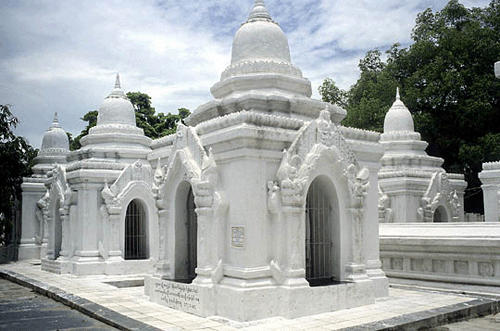Kuthodaw Pagoda (Burmese: ကုသိုလ္ေတာ္ဘုရား, literally Royal Merit, and formally titled Mahalawka Marazein မဟာလောကမာရဇိန်စေတီ) is a Buddhist stupa, located in Mandalay, Burma (Myanmar), that contains the world's largest book. It lies at the foot of Mandalay Hill and was built during the reign of King Mindon. The stupa itself, which is gilded above its terraces, is 188 feet (57 m) high, and is modelled after the Shwezigon Pagoda at Nyaung-U near Bagan. In the grounds of the pagoda are 729 kyauksa gu or stone-inscription caves, each containing a marble slab inscribed on both sides with a page of text from the Tipitaka, the entire Pali Canon of Theravada Buddhism.
Mindon
Min had the pagoda built as part of the traditional foundations of the new
royal city of
The main entrance is from the south through massive but open teak doors ornately carved with floral designs, scrolls, and Deva Nats. It is a covered approach or saungdan as in most Burmese pagodas with frieze paintings under the roof. Between the rows of stone-inscription stupas grow mature star flower trees (Mimusops elengi) that emanate a jasmine-like fragrance to the entire complex. Burmese families may be seen having a picnic in the cool shade under these trees, picking the flowers to make star flower chains for the Buddha or to wear in their hair, or the children playing hide and seek among the rows of stupas. On the southwest inner terrace is one very old tree believed to be 250 years old, its low spreading boughs propped up by supports.
A committee of senior monks, members of the royal family and former officers of the king, including Atumashi Sayadaw (the Abbot of Atumashi Monastery), Kinwon Min Gyi U Kaung (chancellor), Hleithin Atwinwun (minister of the royal fleet), Yaunghwe Saopha Sir Saw Maung and Mobyè Sitkè (a general of the royal army), was formed to start restoration works with the help and donations from the families of the original donors according to custom and also from the public in 1892.[1]
It was the sitkè who asked permission from the senior monks to plant the hkayei star flower trees as well as some meze (Madhuca longifolia) trees. Gold letters were replaced with black ink which made it easier to read. The metal htis of the kyauksa gus were replaced with stone paid for by members of the royal family (155), former officers of the royal army (58), Shan Saophas and Myosas (102), and public donations (414). In 1913 Sir Po Tha, a rice trader of Rangoon, had the pagoda repaired and regilded. The next year, the Society of Pitaka Stone Inscriptions gave an iron gate to the south left open as the carved wooden panels had been destroyed by the soldiers. The west gate was donatedby the famous zat mintha (theatre performer) Po Sein the Great the following year, and the north and east gates by the children and grandchildren of King Mindon in 1932. In 1919 the hermit U Khandi led the rebuilding of the south and west saungdans (covered approaches).[1]
 အေ၀းမွလွမ္းၿမင္ေနရေသာ ကုသိုလ္ေတာ္ဘုရား၏ ရွဳမညီးဖြယ္ရာၿမင္ကြင္း |

ကုသိုလ္ေတာ္ဘုရား၀င္းအတြင္းရွိ ေစတီနငယ္မ်ား
ဘုရား၀င္းအတြင္းတြင္ေတြ.ရေသာ ဇရပ္မ်ား ႏွင္.ခေရပင္မ်ား